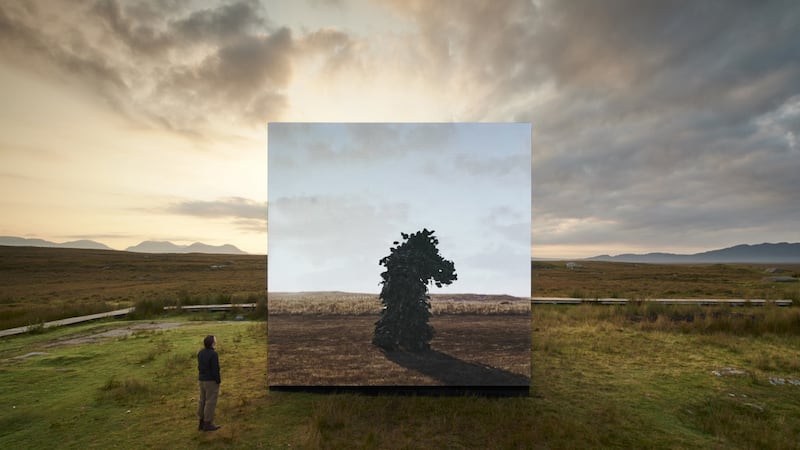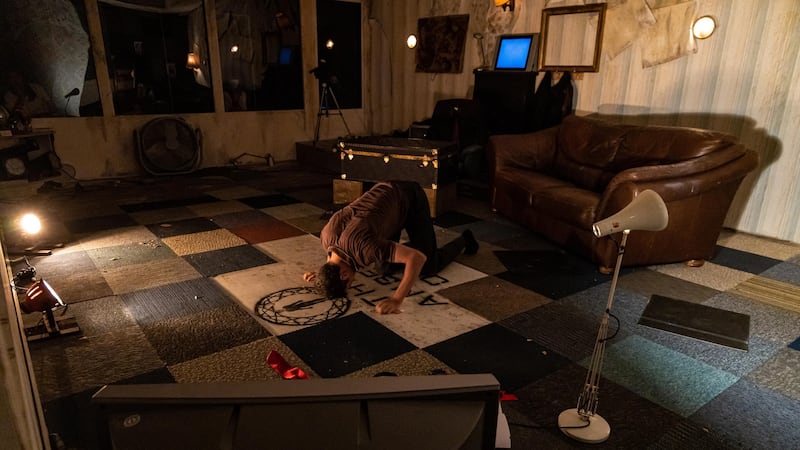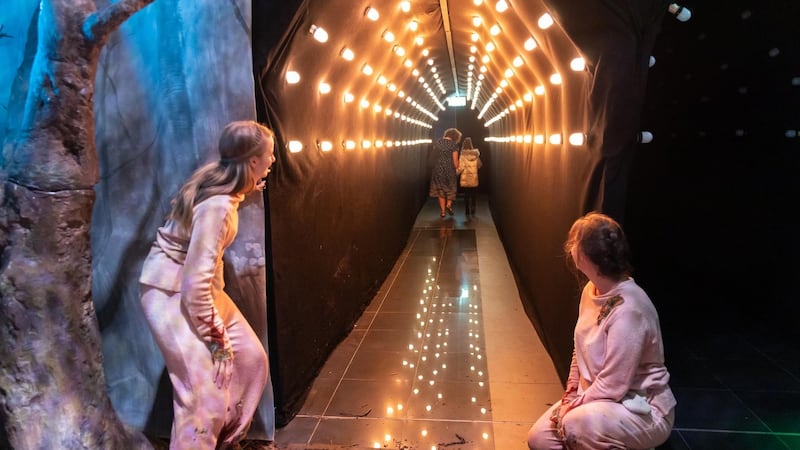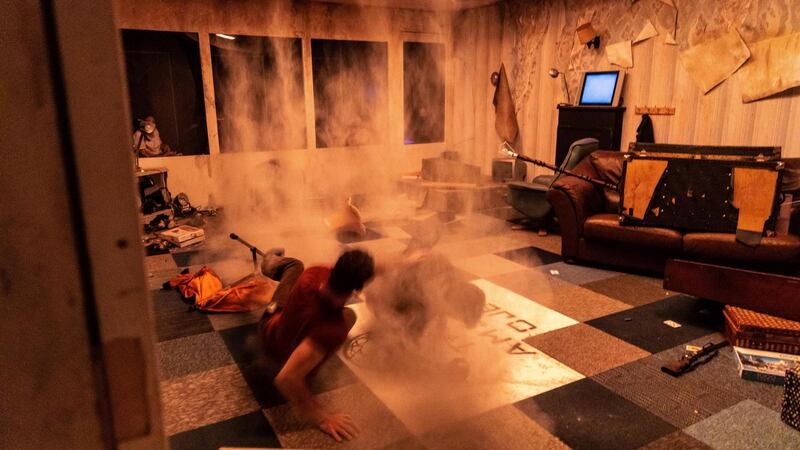Taking place on the cusp of the exceedingly slow reopening of culture, this year’s Galway International Arts Festival was changed utterly. Postponed from July to September, it loosened and spread out, temporally (over three weeks) and geographically, as befits a pandemic-festival.
With a smaller lineup, which fewer people were allowed experience, GIAF’s team led by artistic director Paul Fahy and chief executive John Crumlish nonetheless pulled together a significant festival from the wreckage of Covid, with some excellent and ambitious work. Never mind the width, feel the quality. And happily, just after the festival began, capacity restrictions relaxed, so extra tickets were released.

Almost all of the international festival was Irish, for obvious reasons, making for a concentrated but varied cross-section. Some festival experiences were born of Galway 2020 European Capital of Culture, finding new life after being smothered by Covid. And a number of productions were in Irish, with linguistic concessions made to the majority, who have poor or little Irish, so they were surprisingly accessible.
There was a significant Connemara thread. The best art can bring us to another place, and this literally was the case, out on Inis Oirr on a glorious day; tramping the island’s narrow, stone-wall-lined boreens to the seeming end of the earth was magical. The setting (stone and endless horizon), the staging (stone cairn as Winnie’s mound), performances (Bríd Ní Neactain’s lucid babble trí Gaeilge, and Raymond Keane, all grunts and mumbles) made for a Beckett Laethanta Sona/Happy Days, directed by Sarah Jane Scaife, memorable and moving and magnificent.
Outdoors at Fibin Teo’s base in Baile na hAbhann, past Spiddal, writer/director Philip Doherty created a War of Independence, refracted through a 21st century lens. The epic production involved a cast of 50, live band and original music by Julie Feeney (who also performed) and a series of stages and vignettes, creating evocative imagery and action. This was no dry retelling of history, but selected moments filtered through a character from Cathleen Ní Houlihan thrown into events. He joins ragtaggle rebels, is disguised in a princess frock; the fairground firing range’s revolving targets flip from a row of peelers to dirty rebels; a cookery demo, all sighs and sexiness, on how to make a grenade, is a hoot; smartly edited flickering newsreels create an alternative take on unreality.

Not to say the fight for freedom is played for laughs, but this is humorous and quirky. The knowing, occasionally sardonic tone coexists with stark brutality, exploding with a truck of troops, surrounding the promenading audience. From all over the “village” of stages, their sea shanty Give Us Some Time to Blow the Man Down, at once violent and melodic, bellows threateningly across our heads in the dark. Early turf cutting scenes and soapbox debate give way to the haunting aftermath of Bloody Sunday, washing blood from sheets and jerseys. The tone skilfully straddles horror and humour, typified by amusing Big House scenes as patronising toff welcomes the locals, who then torch his home.
This is a powerful way to mark a centenary: a tour de force, moving, terrifying, funny, intelligent, stylish and entertaining.
In Connemara’s Inagh Valley, tucked away in Interface, a former salmon hatchery turned artists’ workspace run by Alannah Robins, Broken Vessels sees six artists responding in wildly different ways to the setting. The international (remotely due to circumstances) collaboration curated by South African artist Brent Meistre explores containment, displacement, rebuilding. Christine Dixie’s beautiful billowing indigo scenes on muslin, form a procession above the salmon raceway; revolutionary spoken-word poet Lesego Rampolokeng rants from bush radios in a woodshed, accompanied by an insistent drip from the roof; Louise Manifold’s film creates an apocalyptic vista; sound artist Anne Marie Deacy’s hanging sheets of corrugated iron are haunting, vibrating eerily on touch; Noelle Gallagher’s paintings find beauty in the unexpected, including Sitka spruces; Monique Pelser’s ticklesome work exists only as effect–- an American eagle suspended endlessly inside a hatchery tank – conjured via QR code.
Deeper into Connemara, south of Clifden near Alcock and Brown’s landing, is far removed from last year’s first iteration, in the city near Claddagh, of John Gerrard’s Mirror Pavilion, a GIAF/Galway 2020 project. This year’s, Leaf Work, sees the giant mirrored cube in the middle of an ancient bog at Derrigimlagh.

Like an erratic, an alien structure dropped onto the bog, one side of the cube loops a virtual version of the setting, as an oakleaf clad figure moves endlessly. On the other sides the mirror reflects the landscape back to ourselves, a comment on what we’re doing to that landscape.
It was a bit of a pilgrimage getting there. Then a 25 minute walk, and Mirror Pavilion looms, stunning in its unexpectedness, the contrast striking between wild bog and precision tech, a startling temporary intervention in landscape.
Back in the city, Joy Gerrard (sibling, but no relation in the work) was showing more images very much for our times. Precarious Freedom: Crowds, Flags, Barriers, at the temporary Festival Gallery (again in An Post’s former telephone exchange) comprises drawings and large-scale installations of protests in urban spaces. Monochrome, with a photographic quality, they’re at once detailed and impressionistic. The cumulative effect is stirring.

Two dance-ish shows got great response: Stephanie Dufresne’s After Love melds dance, theatre, video, original song, and Dani Gill’s poetry, creating a narrative and meditation on the end of a long-term relationship. It moves from the playful joyousness of early relationship, through togetherness, conflict, then breakup, when “the ghost of you chases me”, as the reality of loss becomes real. After Love, performed by Dufresne and Lewis Wilkins, is honest, raw and very emotionally affecting. As its (original) song goes, “There is a lot think about, after love.”
Dance-threatre doesn’t even half describe Volcano, written, directed and choreographed by Luke Murphy, who performs with Will Thompson. Original, complex and skilful, it’s like an episode of Black Mirror on steroids, extended into a four-part mini-series, that’s also a sci-fi thriller with a philosophical bent. Two men find themselves in a tatty room, without knowing why they’re there, and it transpires over four 45-minute episodes (see them live separately or together, or online), that they’re being controlled as part of The Amber Project. Or, the whole thing may be virtual reality, or even their own subconscious. This is absorbing, exciting, creepy, clever. The tech and design are impressive. There’s also outstanding dancing, of all hues. Oh, yeah, and it’s only performed for eight people at a time, each in a separate pod watching, peep-show style. It makes for an intense, thought-provoking and exhilarating experience.
Enda Walsh’s Medicine, a work-in-progress for GIAF2020, crystalised this year into a brutal and darkly funny play dealing with mental distress. His horizons narrowed for Walsh’s Bedsit, the latest of his “rooms” installations created with GIAF’s Paul Fahy. This time it’s a detailed, realistic, compact home that we intrude upon for Ruth McCabe’s voice monologue, a touching day-in-the-life meditation on a confined existence.

The format of Brú Theatre’s Ar Ais Arís emerged from pandemic restrictions. Director James Riordan explores themes of emigration, using VR headsets to bring us from where we sit on the waterside at Galway Commercial Boatclub, suitcases ready, out to Connemara. Based on work by Máirtín Ó Cadhain, Pádraic Ó Conaire and Nuala Ní Dhomhnaill, the three very short pieces – dance, song, performance – are absorbing, evocative and sometimes unsettling.
That was originally a Galway 2020 project; another that found air to breathe again during GAIF was Branar’s Sruth na Teanga (Stream of Language), aiming for an intimate, immersive trip through the epic sweep of Irish language – and identity – for audiences of all ages. East of the city, the former airport’s terminal was transformed by creator-director Marc Mac Lochlainn into a promenade through several rooms. Ancient forest teases legends through shadow puppetry boxes; original delicate watercolour animated film moves through early Christian, Viking and Norman; miniature scenes depict famine, emigration, penal times and rediscovery. Comic scenes in an archive amuse and contextualise. Beautifully realised by designer Maeve Clancy, it sparkles, with a sprinkling of English to elucidate, putting the language into the context of history.
Interestingly, a significant proportion of the audience has been adults rather than families, and the show could be expanded – for a longer show savouring some elements that are fleeting, and for a longer run.
There was more, much more, in a festival that successfully sidestepped the restrictions. The wonder was that they managed such an extensive and varied festival at all, never mind that one that hit multiple high notes. A joy to return.
Festival concluded; some of the extensive digital version still available online; Broken Vessels continues till Sept 22nd. Giaf.ie












